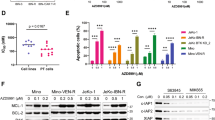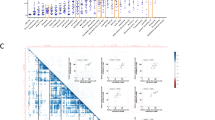Abstract
Non-Hodgkin Lymphoma (NHL) constitutes a very heterogeneous group of diseases with different aggressiveness. Diffuse large B-cell lymphoma (DLBCL) and Burkitt’s lymphoma (BL) are two clinically aggressive lymphomas from the germinal center, very heterogeneous and with different genetic signatures. Several intracellular pathways are involved in lymphomagenesis, being BCR/PI3K/AKT/mTOR and RAS/RAF pathways the most frequently ones. In this context the therapeutic potential of a mTOR inhibitor – everolimus – and a RAS/RAF pathway inhibitor – L744,832 – was evaluated in two NHL cell lines. Farage and Raji cells were cultured in the absence and presence of several concentrations of everolimus and L744,832 in monotherapy and in combination with each other, as well as in association with the conventional chemotherapy drug vincristine. Our results show that everolimus and L744,832 induce antiproliferative and cytotoxic effect in a time-, dose-, and cell line-dependent manner, inducing cell death mainly by apoptosis. A potentiation effect was observed when the drugs were used in combination. In conclusion, the results suggest that everolimus and L744,832, alone or in combination, could provide therapeutic benefits in these subtypes of NHL.



Similar content being viewed by others
References
Shankland KR, Armitage JO, Hancock BW (2012) Non-Hodgkin lymphoma. Lancet 380(9844):848–57
Stein H, Warnke RA, Chan WC, Jaffe ES, Chan JKC, Gatter KC, Campo E (2008) Diffuse large B-cell lymphoma, not otherwise specified. In: Swerdlow S, Campo E, Harris N, Jaffe E, Pileri S, Stein H et al (eds) WHO classification of tumours of haematopoietic and lymphoid tissues. IARC, Lyon, pp 233–237
Schneider C, Pasqualucci L, Dalla-Favera R (2011) Molecular pathogenesis of diffuse large B-cell lymphoma. Semin Diagn Pathol 28(2):167–177
Lenz G, Staudt LM (2010) Aggressive lymphomas. N Engl J Med 362(15):1417–1429
Kenkre VP, Stock W (2009) Burkitt lymphoma/leukemia: improving prognosis. Clin Lymphoma Myeloma 9(Suppl 3):S231–8
Bornkamm GW (2009) Epstein-Barr virus and its role in the pathogenesis of Burkitt’s lymphoma: an unresolved issue. Semin Cancer Biol 19(6):351–65
Vose JM, Chiu BC, Cheson BD, Dancey J, Wright J (2002) Update on epidemiology and therapeutics for non-Hodgkin’s lymphoma. Hematol Am Soc Hematol Educ Prog 2002:241–262
Hennessy BT, Hanrahan EO, Daly PA (2004) Non-Hodgkin lymphoma: an update. Lancet Oncol 5(6):341–353
Castagna L, Magagnoli M, Demarco M, Santoro A (2007) Lymphomas. Updat Cancer Ther 2(2):101–110
Michallet AS, Coiffier B (2009) Recent developments in the treatment of aggressive non-Hodgkin lymphoma. Blood Rev 23(1):11–23
Murawski N, Pfreundschuh M (2010) New drugs for aggressive B-cell and T-cell lymphomas. Lancet Oncol 11(11):1074–85
Parcells BW, Ikeda AK, Simms-Waldrip T, Moore TB, Sakamoto KM (2006) FMS-like tyrosine kinase 3 in normal hematopoiesis and acute myeloid leukemia. Stem Cells 24(5):1174–1184
Small D (2006) FLT3 mutations: biology and treatment. Hematol Am Soc Hematol Educ Prog 2006:178–184
Morschhauser F, Bezombes C, Jardin F (2010) Targeting molecular pathways. Education Program for the 15th Congress of European Hematology Association 4(1):118–123
Hachem A, Gartenhaus RB (2005) Oncogenes as molecular targets in lymphoma. Blood 106(6):1911–1923
Easton JB, Houghton PJ (2006) MTOR and cancer therapy. Oncogene 25(48):6436–6446
Polivka J Jr, Janku F (2014) Molecular targets for cancer therapy in the PI3K/AKT/mTOR pathway. Pharmacol Ther 142(2):164–175
Niemann CU, Wiestner A (2013) B-cell receptor signaling as a driver of lymphoma development and evolution. Semin Cancer Biol 23P:410–421
Bojarczuk K, Bobrowicz M, Dwojak M, Miazek N, Zapala P, Bunes A, Siernicka M, Rozanska M, Winiarska M (2015) B-cell receptor signaling in the pathogenesis of lymphoid malignancies. Blood Cells Mol Dis 55(3):255–65. doi:10.1016/j.bcmd.2015.06.016
Costa CB, Casalta-Lopes J, Andrade C, Moreira D, Oliveira A, Gonçalves AC, Alves V, Silva T, Dourado M, Nascimento-Costa JM, Sarmento-Ribeiro AB (2012) Farnesyltransferase inhibitors: molecular evidence of therapeutic efficacy in acute lymphoblastic leukemia through cyclin D1 inhibition. Anticancer Res 32(3):831–838
Song SY, Meszoely IM, Coffey RJ, Pietenpol JA, Leach SD (2000) K-Ras-independent effects of the farnesyl transferase inhibitor L744,832 on cyclin B1/Cdc2 kinase activity, G2/M cell cycle progression and apoptosis in human pancreatic ductal adenocarcinoma cells. Neoplasia 2(3):261–272
Adjei AA, Davis JN, Erlichman C, Svingen PA, Kaufmann SH (2000) Comparison of potential markers of farnesyltransferase inhibition. Clin Cancer Res 6(6):2318–2325
Beck LA, Hosick TJ, Sinensky M (1990) Isoprenylation is required for the processing of the lamin a precursor. J Cell Biol 110(5):1489–1499
Kilic F, Salas-Marco J, Garland J, Sinensky M (1997) Regulation of prelamin A endoprotease activity by prelamin A. FEBS Lett 414(1):65–68
Brunner TB, Hahn SM, Gupta AK, Muschel RJ, McKenna WG, Bernhard EJ (2003) Farnesyltransferase inhibitors: an overview of the results of preclinical and clinical investigations. Cancer Res 63(18):5656–5668
Appels NM, Beijnen JH, Schellens JH (2005) Development of farnesyl transferase inhibitors: a review. Oncologist 10(8):565–578
Chan S (2004) Targeting the mammalian target of rapamycin (mTOR): a new approach to treating cancer. Br J Cancer 91(8):1420–1424
Wolpin BM, Hezel AF, Abrams T, Blaszkowsky LS, Meyerhardt JA, Chan JA, Enzinger PC, Allen B, Clark JW, Ryan DP, Fuchs CS (2009) Oral mTOR inhibitor everolimus in patients with gemcitabine-refractory metastatic pancreatic cancer. J Clin Oncol 27(2):193–198
Frost P, Moatamed F, Hoang B, Shi Y, Gera J, Yan H, Frost F, Gibbons J, Lichtenstein A (2004) In vivo antitumor effects of the mTOR inhibitor CCI-779 against human multiple myeloma cells in a xenograft model. Blood 104(13):4181–4187
Wendel HG, De Stanchina E, Fridman JS, Malina A, Ray S, Kogan S, Cordon-Cardo C, Pelletier J, Lowe SW (2004) Survival signalling by Akt and eIF4E in oncogenesis and cancer therapy. Nature 428(6980):332–337
Houghton PJ (2010) Everolimus. Clin Cancer Res 16(5):1368–1372
Scholzen T, Gerdes J (2000) The Ki-67 protein: from the known and the unknown. J Cell Physiol 182(3):311–322
Yang Q, Guan KL (2007) Expanding mTOR signaling. Cell Res 17(8):666–681
Kelly KR, Rowe JH, Padmanabhan S, Nawrocki ST, Carew JS (2011) Mammalian target of rapamycin as a target in hematological malignancies. Target Oncol 6(1):53–61
Recher C, Dos Santos C, Demur C, Payrastre B (2005) MTOR, a new therapeutic target in acute myeloid leukemia. Cell Cycle 4(11):1540–1549
Sander S, Calado DP, Srinivasan L, Kochert K, Zhang B, Rosolowski M, Rodig SJ, Holzmann K, Stilgenbauer S, Siebert R, Bullinger L, Rajewsky K (2012) Synergy between PI3K signaling and MYC in Burkitt lymphomagenesis. Cancer Cell 22:167–179
Acknowledgments
The present work was supported by CIMAGO – Center of Investigation on Environment, Genetics and Oncobiology, Faculty of Medicine, University of Coimbra, Portugal, by funds from FEDER through the Operational Program Competitiveness Factors – COMPETE –, and by portuguese funds through FCT – Foundation for Science and Technology – under the strategic projects from FCT/MCTES/PIDDAC (to CNC, Center Reference: UID/NEU/04539/2013). R. Alves was supported by the FCT fellowship SFRH/BD/51994/2012. The funders had no role in study design, data collection and analysis or manuscript preparation.
Author information
Authors and Affiliations
Corresponding author
Ethics declarations
Conflict of Interest
The authors declare no conflict of interests.
Rights and permissions
About this article
Cite this article
Mendes, J., Gonçalves, A.C., Alves, R. et al. L744,832 and Everolimus Induce Cytotoxic and Cytostatic Effects in Non-Hodgkin Lymphoma Cells. Pathol. Oncol. Res. 22, 301–309 (2016). https://doi.org/10.1007/s12253-015-9998-4
Received:
Accepted:
Published:
Issue Date:
DOI: https://doi.org/10.1007/s12253-015-9998-4




